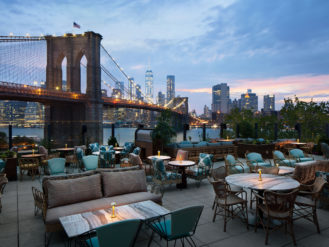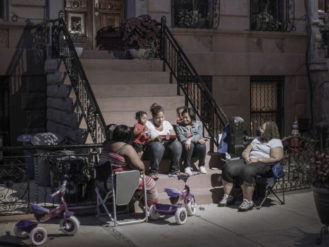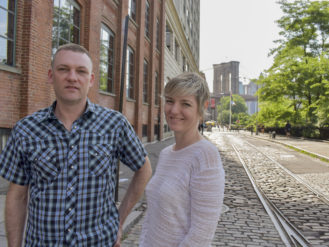A Democratic House Candidate Plays Against Type
“I wish I could have had the luxury, like you, of growing up and living and spending my entire life in a nice place like the First District of Arizona, but I was doing other things. As a matter of fact, when I think about it now, the place I lived longest in my life was Hanoi.” —Navy veteran John McCain, after being called out for carpetbagging during his first race for Congress in 1982
“I would’ve come here sooner; I was too busy defending my country in Afghanistan.”—Congressional candidate Max Rose, responding to an accusation that he “is not one of us”
The 11th Congressional District is an exception to the almost uniformly blue carpet of the New York City electoral map. It’s the most conservative Congressional district in the city, the only one with a Republican representative, and went for Donald Trump by eight percentage points in 2016. Staten Island comprises most of the district, but about a quarter of its voters live in a stretch of southern Brooklyn neighborhoods from Bay Ridge to Gravesend.
This year’s Democratic candidate, a purple-hearted, bronze-starred, Afghan War veteran named Max Rose, happens to have been born in Brooklyn, but watching his campaign, and his performance in a recent debate, one must concede that Rose does a pretty good job of appearing to be Staten Island to the core.
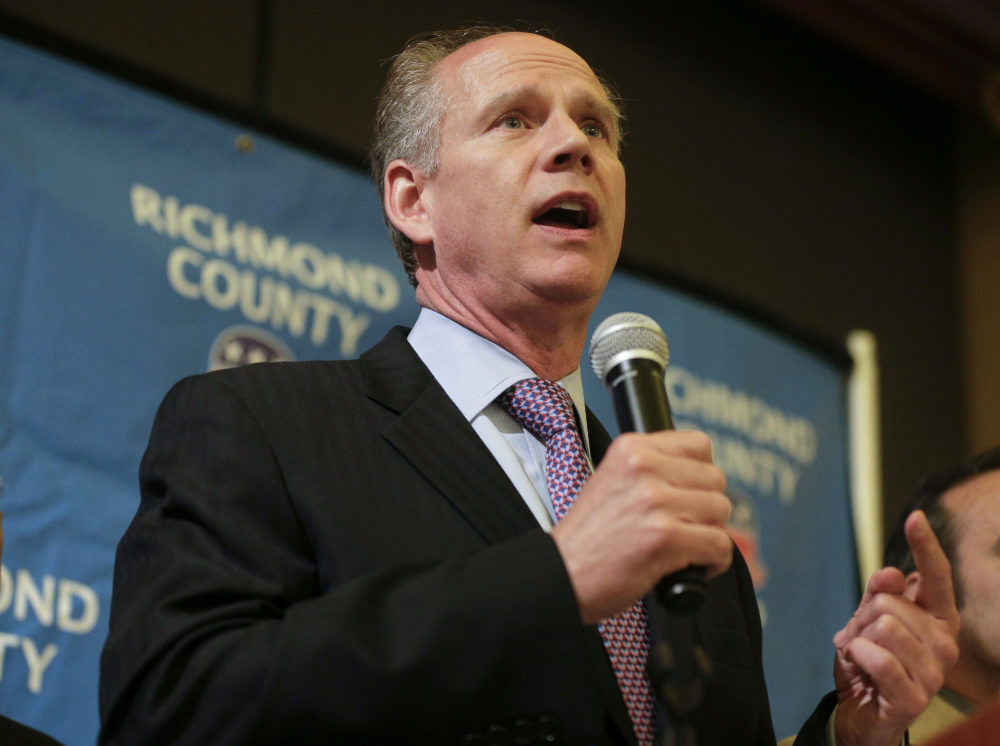
Incumbent Congressman Donovan giving his acceptance speech on election night in 2015 (AP Photo/Julie Jacobson, File)
His crossover style is getting results. While the district might have looked like a lost cause judging by 2016 results, in which incumbent Dan Donovan won by 25 percentage points, it’s “now seen as a battleground, attracting national attention, and national money,” noted the New York Times, whose polling on Oct. 23-27 showed Donovan having a slight edge, 44% to 40%, with 15% undecided.
Indeed, to veteran election watchers, this year’s race has provided a dramatic role reversal. Though Staten Island once served as home base to the Jesuitical intellectual GOP State Senator John Marchi, recent Staten Island politicians have not been in the mode of wonky altar boys. They’ve tended to be pugnacious street fighters like Borough President Jimmy Oddo and former Congressman Michael Grimm, who famously once threatened to throw a Brooklyn-born reporter off a balcony.
But despite his occasional descent into verbal malaprops like “denucularizin,” it is the Staten Island native Donovan who is sounding like a wonk from the era of Marchi, calmly reminding voters of two-decades old battles he once fought as chief of staff to the Staten Island borough president. And it is the Brooklyn-born Democrat whose demeanor reminds one of Grimm, without the explicit threats of violence. Still, every once in a while, it looks like Rose is ready to heave Donovan over a balcony.
In some parts of the country, Democrats have nominated candidates who think base mobilization will wake up potential left-wing votes, even in places with no discernible history of having them. But in the 11th, Max Rose is just as happy to throw a right hook as one to the left.
Don’t like Mayor de Blasio (and this district decidedly doesn’t)? Max Rose says he’s doing a lousy job. Don’t like Nancy Pelosi? Max Rose wants to dump her. Against abolishing ICE? So is Rose. He opposes a carbon tax and rejects calls for Trump’s impeachment. In fact, Rose states that, when it comes to Trump, he will not be “a pure, unadulterated obstructionist.”
While some of his primary opponents attacked Donovan’s record as DA from the left, sometimes criticizing his failure to indict cops involved in the death of Eric Garner, Rose is attacking Donovan’s record from the right, saying Donovan was soft on the opioid scourge and linking it to Donovan’s campaign contributions from Big Pharma.
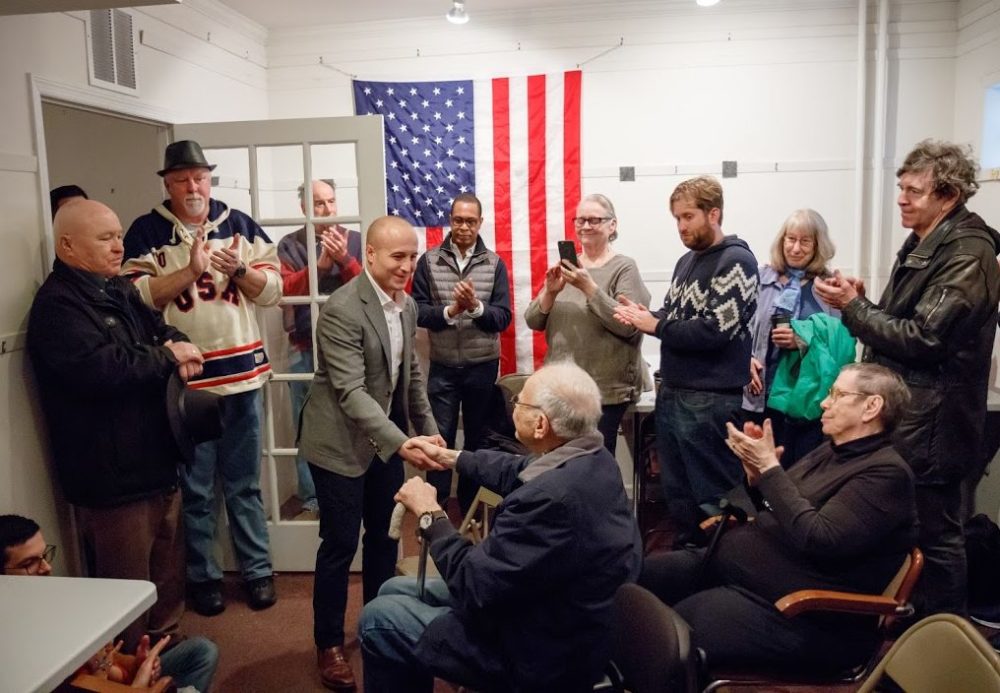
Rose, on the campaign trail, has taken positions contrary to Democratic orthodoxy (Photo courtesy of the Max Rose campaign)
This is not to say that Rose is in any way a conservative. Rose supports health care for all, attacking Donovan for flip-flopping on repeal of the Affordable Care Act. Rose wants to increase taxes on the super rich, opposes Trump’s detention of immigrant children, and attacks Donovan’s wavering position on immigration policy.
What Rose is doing is finding the sweet spot for a constituency which is not all that liberal, but embraces liberal policies it sees in its interest. More importantly, he does this while dog-whistling all the while that he is really “one of us.”
Earlier this year, a lot of national Democrats quietly gave up on this seat once Donovan managed to beat back a Grimm comeback attempt in the primary. Grimm had resigned his seat in 2014 after pleading guilty to felony tax fraud, making him an attractive Democratic target, but Donovan prevailed, largely by making a sharp right turn. Now, veering back to the center, it appears that Donovan may lose to a Democrat who channels much of the Grimm demeanor.
Incidentally, perhaps because Rose knows that he can count on a safe majority of votes from Brooklyn, the borough got considerably less than its share of the recent debate’s attention. Rose did eventually manage to squeeze in mention of the R train, while Donovan admitted he does not even own a MetroCard.
A Rose victory would be seen, especially in the context of Democrats taking the House, as a defeat delivered to Trump in a district he carried. And to some extent, it would be. Democratic Party activists here are loaded for bear and the leadership in both counties is working hard for their Congressional candidate, something they have not always done.
But anti-Trump sentiment here is probably not enough for a Democratic victory. What a Democratic victory here would take is a candidate who can read the local zeitgeist and translate the non-ideological portion of the voter anger which led to Trump’s 2016 victory here—Obama won the district in 2012—into anger against an incumbent regardless of his party.
And, if ever such a candidate existed, it is Max Rose. National Dems and their allies have been spending and contributing large for Rose, regardless of his ideological heresies. While FiveThirtyEight is still calling this race “Likely Republican,” current polling shows the gap dramatically narrower than two years ago. Could an upset be in the cards? Well, it was once inconceivable that voters here would figuratively toss Donovan off the famous bridge nicknamed “the gangplank.” And it is no longer inconceivable.
Why Cuomo’s Plan for Red Hook Faces a Force of Nature
Here’s a fact about New York. The city has an undeniable housing problem—tens of thousands of New Yorkers are homeless, and rents increases have outpaced income rises for years. While rent regulations can be strengthened and pressure can be put on developers to set aside more affordable units, the most straightforward way to deal with a housing shortage is to build more housing. And in New York—as we’ve seen in Williamsburg and Hudson Yards—the easiest place to build new housing is on the waterfront, often replacing the declining shipping industry that once defined the city.
Last week, in a handful of lines from his State of the State speech, New York Governor Andrew Cuomo raised the possibility of another new waterfront housing development, this time in the rising Brooklyn neighborhood of Red Hook. Cuomo called for the Metropolitan Transit Authority (MTA) to consider relocating the the Red Hook marine terminals further south to Sunset Park, which would clear more than 130 acres of publicly-owned waterfront. He also asked the MTA to “study the possibility of a new subway line to stimulate Red Hook’s community-based development.”
The Red Hook plan was one of just dozens initiatives mentioned in Cuomo’s speech, but the scale would be staggering. A subway stop would help solve the transportation isolation that has stemmed Red Hook’s residential growth for decades, while the sheer amount of land that could be redeveloped if the marine terminal is moved would be six times bigger than the $25 billion Hudson Yards complex, currently the largest private real estate development in the U.S. That could potentially mean tens of thousands of new apartments for housing-strapped New Yorkers.
The Bridge contributor Bryan Walsh appears in this video on Red Hook, produced with Brooklyn's BRIC TV (Video by BRIC TV via YouTube)
But here’s another fact about New York. With its 578 miles of shoreline, few cities in the U.S. are more vulnerable to climate change-driven sea level rise—and within New York, few neighborhoods are more vulnerable than low-lying Red Hook, which is surrounded by water on three sides. Superstorm Sandy inundated Red Hook, flooding the Fairway Market and the Red Hook Houses alike. Though early steps have been taken to protect Red Hook from future floods, and more are planned in the years to come, without much more ambitious and expensive barriers, Red Hook is almost certainly going to lose the battle against climate change.
Persistent flooding is a big enough threat to a neighborhood of about 10,000 people, Red Hook’s current population. But if Red Hook’s redevelopment goes forward, tens of thousands of additional people will be moving into the highest-risk flood zones. A subway extension into Manhattan, which would require a new tunnel beneath the East River, would be another point of climate vulnerability. (Just ask Williamsburg residents how they’re planning to cope with the 18 month-long closure of the L train’s Brooklyn-Manhattan segment, which suffered catastrophic damage during Sandy.) After the most expensive year on record for natural disasters in the U.S., at a moment when climate-change experts are urging a managed retreat from the rising seas, New York is poised to double down on its waterfront.
Of course, the Red Hook redevelopment may never happen. Earlier plans by the engineering firm AECOM to turn Red Hook into the next Battery Park City have gone nowhere, and if the badly over-budget Second Avenue subway and Number 7 line extensions are any indication, building a new underwater subway tunnel—the first in decades—could be prohibitively expensive. Existing Red Hook residents may fight a development plan that would so utterly change the character of their sleepy neighborhood.
But even if Red Hook remains unchanged, waterfront redevelopment won’t stop—and neither will New York’s growing exposure to sea-level rise. Hudson Yards, the Brooklyn Navy Yard, the new luxury apartment towers in Williamsburg—they all lay within the city’s projected 2050 floodplain. Developers can take actions to protect individual buildings from flooding—already the case with some of Red Hook’s newest high-end waterfront projects—but that adds cost. And it won’t do residents much good if their apartments remain high and dry but the subways and other infrastructure they need is flooded out.
Read our recent three-part special report on Red Hook’s vulnerability, the recovery of its businesses after Sandy, and a tale of two dwellings in the flood zone.
But the bulk of New York’s recent residential development hasn’t been done on the shoreline just because buyers’ love a water view—though that does play a part. Building along the waterfront is usually the easiest option in an already crowded city. The waterfront is often publicly owned, as is the case with the Red Hook terminals, and industrial tenants can be moved, if they haven’t already left the space vacant. There are fewer community groups to tussle with, few historic landmarks that must be preserved. Often waterfront land is simply created—Battery Park City was reclaimed from the Hudson River with landfill left over from the construction of the World Trade Center and other projects, while Red Hook was marshland and tidal ponds before it was filled in.
This drone-flyover video provides an aerial tour of Red Hook, noting areas affect by Hurricane Sandy (Video by The Bridge via YouTube)
After Sandy, then-Mayor Bloomberg said that New York “cannot and will not abandon our waterfront.” But we shouldn’t be surprised when the water reclaims land that was taken from it. This is New York’s dilemma in a time of the housing and climate crises. The simplest solution to the first will almost surely make the second worse.
This doesn’t mean that New York needs to stop building new housing—nor can it. But sustainable and affordable growth in a warming world could mean eschewing the waterfront for denser housing on higher land. The good news is that as much as New York is a city of the coast, it has plenty of high ground in Upper Manhattan and through parts of Queens and Brooklyn, including (as the names suggest) Park Slope and Jackson Heights. The downside: unlike the industrial waterfront, that land is already settled, and NIMBY-minded communities may not take kindly to greater density. We may find out soon which has a more implacable will—the rising seas, or New York homeowners.
Whatever Happened to Brooklyn’s Political Clout?
There was a time when Brooklyn was the center of New York’s political universe.
We refer to that time by using the word “history.”
The County of Kings has long been the state’s largest, and when it came to power positions in the state and city legislature, Brooklyn was once almost literally the County of Kings.
Except for a short interval in 1968, Brooklyn held the top Democratic leadership position in the State Assembly steadily from 1930 to 1991, which meant that a Brooklynite held the Assembly speakership when the Democrats were in the majority (1935, 1965-68 and 1975-91). On the City Council, Brooklyn held the top position, then called majority leader, from 1938-61 and then again from 1969-85.
The last Brooklynite to serve as leader of the City Council was Thomas Cuite of Windsor Terrace, who was majority leader during that 16-year span ending in 1985.
In the last three decades, Brooklyn hasn’t had much luck at running the Council, directly or otherwise. And since losing the Assembly speakership in 1991 to a Brooklyn pol’s fraud conviction, the borough hasn’t managed to get it back.
Yes, our current mayor hails from Park Slope, but he is an exception to the rule. This week, Council member Corey Johnson of Manhattan is expected to be chosen as the new speaker, beating back several rivals including Council member Robert Cornegy Jr. of Brooklyn.

Council Member Corey Johnson of Manhattan is the favorite in this week’s election of a new speaker
The reasons for the decline of Brooklyn’s political machine vary. Some of it is the borough’s own factional warfare, although the worst factional warfare of the 1960s, between Stanley Steingut (an ally of Sen. Robert Kennedy) and Anthony Travia (aligned with Mayor Robert Wagner), didn’t ultimately stop both men from serving as Assembly speaker.
Some of of the blame can be put on ineffective leadership. Howard Golden, the Brooklyn borough president (1977-2001) and Democratic leader, thought himself a smart player, but got outplayed by kingmakers Donald Manes of Queens and Stanley Friedman of the Bronx. Manes and Friedman won themselves a Council speaker (Peter Vallone of Queens) and then got themselves arrested in practically the next moment (Manes made his first suicide attempt almost immediately after leaving Vallone’s victory party), leading one to conclude that maybe Golden was the more savvy survivor after all.
Golden’s successor, the hapless Clarence Norman, got the worst of both worlds, failing to win the leaderships and failing to avoid jail (a fate which also befell his candidate for the Council leadership). Norman’s successor, Vito Lopez, was far better than Norman at wielding an iron fist, but lacked such leadership skills as the ability to smile and say thank you.
And they all had bad luck.
The Lack of Leverage
So, what does that matter to us in Brooklyn?
Well, the speaker of the Assembly and the speaker of the Council, along with their top lieutenants, allocate resources, having control over various pots of funding and the ability to leverage others. Who gets what funding for which groups serving which neighborhoods is a large part of what a speaker decides.
To a great extent, legislative leaders decide whose quids get quo’ed. They decide which laws get passed and which don’t. They have large payrolls to work with. Council speakers approve every zoning change. Their pet projects often become those of the mayor and governor.
Robert Moses may have been the most powerful person in New York State in his day, but his desire to connect the Interboro Expressway to Brooklyn’s other highways still had to give way to Tony Travia’s desire not to see his neighborhood plowed over. As Travia had just helped Moses bury Mayor Lindsay’s plan to have the city take over Moses’ Triborough Bridge and Tunnel Authority, Travia had some leverage to assert.
Even a lesser leadership position in the right hands, leveraging influence properly, can change the city’s landscape. The Jacob Javits Convention Center exists today largely because State Senate Minority Leader Manfred Ohrenstein wanted it to.
Closer to home, we have Brooklyn Bridge Park today largely because of the cleverness of State Senate Minority Leader Martin Connor of Brooklyn Heights, working together with the chair of the Assembly’s Economic Development Committee, Eileen Dugan of Carroll Gardens.
So the fact that Brooklyn hasn’t held the Council leadership since 1991 and has rarely played a crucial role in choosing that leader has probably made differences to our lives and probably will do so again.
This is not always a bad thing. Not everyone loves the compromises inherent in how we got Brooklyn Bridge Park. Such compromises eventually played a crucial role in Connor’s political downfall. Some people don’t like Atlantic Yards (since renamed Pacific Park), a product of the best-buds relationship between former Brooklyn Borough President Marty Markowitz and former Mayor Bloomberg. The distance between one Brooklynite’s pet peeve and one Brooklyn pol’s pet project is often quite short.
City Council Intrigue
Brooklyn’s Council troubles began as 1985 turned to 1986, when a leadership vote took place to choose the new majority leader. The candidates were Vallone, backed by the members of the delegations from Queens, the Bronx and Staten Island, and Sam Horwitz of Brooklyn, backed by his home delegation and ostensibly that of Manhattan. If the boroughs had voted in that manner, the vote would have been 18-17 for Horwitz.
There were originally four candidates. The Brooklyn delegation was divided into factions loyal either to borough president Golden or his rival Tony Genovesi. There was always a question whether the Manhattan delegation would stick together. I was then chief of staff to Council Member Carolyn Maloney and remember the moment Carolyn told me that the Manhattan delegation had pledged to unite behind Horwitz. But as an alliance, it didn’t add up. The Upper East Side’s Robert Dryfoos was close with the Queens claque. I looked at Carolyn and asked, “Even Dryfoos?”
Just before the vote, the Manhattan delegation met at Maloney’s City Hall office. As the delegation members sat at a table, Council Member Stanley Michels asked the members one-by-one to raise their hand and pledge to cast their vote for Sam Horwitz. Dryfoos at first tried to paraphrase Barzini’s speech from the Godfather: “Look, we are all reasonable men here. We don’t have to give assurances as if we were lawyers.” But the two of them were lawyers and, arguably, none of them were reasonable. They all raised their hands to pledge and Dryfoos joined them.
A lot of good it did. They then walked across Chambers Street to City Hall. The roll call began, and when it got to Dryfoos, he pulled a typewritten speech out of his pocket and explained why he was voting for Vallone. More than a decade later, at a judicial induction in Brooklyn, Howie Golden was still angry enough to throw Dryfoos out of Borough Hall.
After the passage of a city charter change, Vallone’s title changed to council speaker and his power increased. In 2002, when he reached his term limit, the Queens and Bronx county leaders once again called the tune, and Manhattan’s Gifford Miller beat out Brooklyn’s Angel Rodriguez (who later copped a plea to trying to extort the developers of the Ikea store in Red Hook). Manhattan got the speakership, but most of the other plumbs ended up with the victorious bosses, with Queens getting the Chair jobs at both Finance and Land Use, the two most powerful committees.
In 2006, the same scenario ensued, as Manhattan’s Christine Quinn beat out Brooklyn’s de Blasio, with the Queens and Bronx string-pullers now being joined by Brooklyn boss Lopez (with a fragmented delegation, he had fewer votes to deliver) in a supporting role. As a result, Brooklyn got a slightly better cut of table scraps, though it wasn’t until Quinn’s second term that Brooklyn got the chair of the Finance Committee.
Rise of the Progressives
In 2014, Brooklyn threw a change-up.
The big three county leaders (Brooklyn, Queens and the Bronx) once again agreed that they would be the ones to determine which Manhattan member got to be speaker, and they chose Dan Garodnick. However, a rising Progressive Caucus, focusing on social justice, made deep inroads into every delegation and their Manhattan candidate, Melissa Mark-Viverito, made it a tight race with the support of newly elected Mayor de Blasio.
Brooklyn’s party leader, Frank Seddio, was playing with fewer cards than his outer-borough counterparts. Though Brooklyn is the largest borough, the Progressives had made the deepest inroads into his realm. But he decided to turn his weaknesses into strengths. The very fact Brooklyn had so many Progressives meant Seddio had had to develop strong working relationships with them, and those relationships included the new mayor.
Seddio decided to take a gamble: he would try to deliver his non-progressive loyalists to the mayor’s candidate, Mark-Viverito. If he lost, he would still have acquired a big chit with the mayor. Seddio took his shot and won, becoming the queen-maker. His ally, David Greenfield, became chair of the Land Use Committee. Frank Seddio became a lot more important, though for four years, the Queens and Bronx leaders have said nary a word to him.
The Current Race
As 2018 dawns, most of the Council Members have remained the same, but the lay of the land has shifted. Mark-Viverito has reached her term limit. The Progressive Caucus, hoping to produce her successor, ran into a roadblock when the mayor’s preferred candidate, Julissa Ferreras-Copeland, decided to move to Maryland with her family.
Seven members of the Progressive Caucus decided to run for speaker. In some ways this meant that there were seven out of eight chances that the speaker would be a Progressive. But in the only way that counted, it meant that none of them would be. All those candidates may have been Progressive, but there was no singularly strong Progressive candidate. The important unions, previously part of their coalition, fragmented their support. The county leaders again become crucial, but not the county leader who had been crucial the last time.
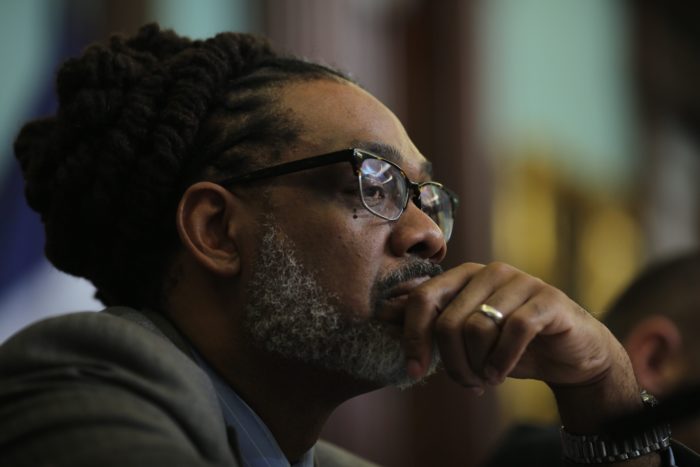
Brooklyn Council Member Robert Cornegy, who has the backing of the borough’s party leader
Seddio stuck with the mayor (who delayed in endorsing any particular candidate), but the mayor is now a lame duck and, in many ways, had worn out his welcome in the districts of many of the white members of the council. As a result, the Brooklyn members most likely to stick with Seddio were usually the ones least interested in sticking with the mayor.
By December, everyone could see that Seddio would not be the kingmaker again. Not one speaker candidate attended the Christmas party at Seddio’s home political club.
But Seddio played well the cards he was dealt. Seddio did a couple of large favors for Manhattan Democratic Leader Keith Wright, including siding with him on filling a State Senate vacancy. Meanwhile, Seddio lay in wait for a chance to make a smart move, occasionally taking the time to let people to know that his own preferred speaker candidate, Brooklyn’s Robert Cornegy Jr., might make a great compromise candidate. After all, Cornegy, a former pro-basketball player of towering height, was the only candidate the mayor would have to look up to.
Queens Party Leader Joe Crowley and the Bronx’s Marcos Crespo waited until the mayor was in Iowa to deliver their votes to Council member Corey Johnson, an openly gay white male from Christine Quinn’s old Chelsea district, who had carefully accumulated a strong bloc of votes on his own by a combination of aggressive campaigning and munificent largesse. Keith Wright joined with them and the mayor called to say “uncle” in as positive a manner as he could muster.
Seddio most likely is still smiling, having cemented his relationship with the lame duck who still has absolute power over many aspects of city government for the next four years. So perhaps the ju-jitsu master Seddio has still made the best of a bad situation. If Brooklyn could be said in 2006 to have won poorly, one might be able to argue that in 2018, it has lost very well.
But the vote hasn’t yet taken place and there are still three Brooklyn candidates in the race. Can anyone “pull a Dryfoos?” The short answer is no; the contest is over. So, what is this all about?
Race.
For the first time since 2005, the speaker will be a white male. In a majority-minority city, two of the three citywide officials are white males, and in a majority-minority Council, the new leader is a white male as well. With African-American votes having proven crucial to recent Democratic victories in Alabama and Virginia, some city leaders, like the Rev. Jacques Andre DeGraff, see this as “a slap in the face.”
“There’s a sense that black Democrats are not being supported by the establishment,” said Marc Morial, the head of the National Urban League.
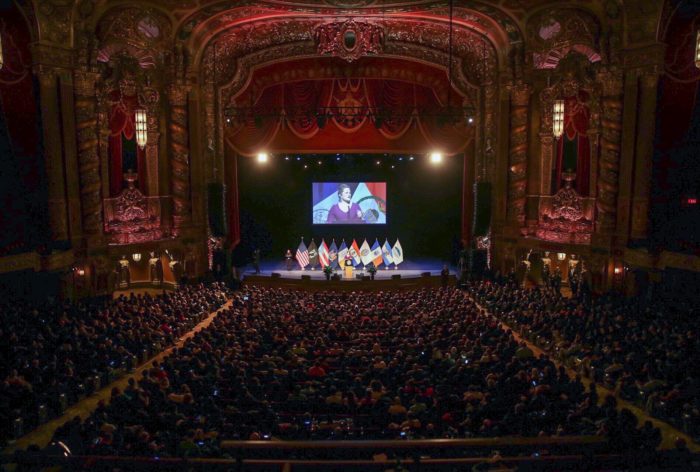
Council speaker Mark-Viverito gave her state-of-the-city speech last year at Brooklyn’s Kings Theatre, but the borough’s current political influence doesn’t match the grandeur of the hall
Despite a liberal record, Cornegy, the only non-member of the Progressive Caucus to contest the race, was regarded by many as the most moderate, business-friendly candidate. Now his supporters, including political operative Charlie King, are saying things like, “There is no black political power in New York City. You cannot call New York City a progressive city when you have no black elected officials in positions of power,” said King.
Cornegy’s candidacy is joined in its lingering-on by that of fellow Brooklynite Jumaane Williams, one of the Council’s most left-wing members on economic and racial justice issues, who was so intent on becoming Speaker that he abandoned long held conservative positions on social issues. The move got him some favorable press, but no new votes.
The race’s last chapter seems even more quixotic for Williams than it is for Cornegy, who was seen during the speaker’s race as the best long-shot choice, with a plausible scenario for victory. Some are now seeing the lack of concession by Cornegy and Williams as a move to ensure a better price in bargaining chits for the eventual unity photo. Hence the new candidacy of Inez Barron, who has promised to fight until the bitter end even if Cornegy and Williams both fold and even if the only vote she receives is her own.
So, there will be no Brooklyn speaker, but do the three Brooklyn candidates and their supporters have a point? It depends on how you look at it.
The Council members who choose the speaker are majority non-white. Though Queens Leader Joe Crowley is white, he represents a Latino-majority district in Congress and his county organization installed Queens’ first black borough president and its first Asian member of Congress.
And Crowley couldn’t have picked a winner without the support of the Bronx leader Marcos Crespo, a Latino, and the Manhattan Leader, Keith Wright, an African-American whose father was civil-rights pioneer Judge Bruce Wright.
While it is true the proportions of minority power positions in the city can currently be called low, the arc of history has bent toward diversity. We’ve had a black mayor, we have a black public advocate, and we’ve had two comptrollers of color, one of whom was African-American. The current mayor holds his post because he first won nomination by beating a black candidate among black voters.
We’ve never had a black speaker, but the outgoing speaker is a Latina, as is the Finance Committee chair. Likely, one or both of the incoming Finance and Land Use chairs will be minority members, which the Cornegy/Williams moves are probably meant to ensure.
The current lineup of legislative-leadership positions in New York State offers a different picture. The most powerful Democrat in the state, other than the governor, is Assembly Speaker Carl Heastie of the Bronx, who is African-American. The Democratic Party leader in the legislature’s other house is State Senator Andrea Stewart-Cousins of Yonkers, an African-American. Her last three predecessors were also African-Americans, one of whom eventually become governor.
While African-American leaders have reason to be disappointed in the results of the contest for Council speaker, it can still be argued that holding two of the three top Democratic legislative positions is a sign of strength rather than weakness.
At any rate, it would appear that if one is trying to elect an African-American City Council speaker, or any speaker at all these days, one is best off finding a candidate who comes from a place other than Brooklyn–at least until the borough gets its political mojo back.
How Fixing an Overstressed Region Could Change Brooklyn
Even as New York City has flourished in recent years, its physical flaws have become painfully apparent: broken-down subways, unaffordable housing and vulnerability to climate change, among other ills. All of these hit home particularly hard in Brooklyn, the most populous borough. Can they be fixed?
It’s easy to dismiss such problems as too big to tackle. But one group, the Regional Plan Association (RPA), considers those challenges its reason for being. The venerable research group, funded by businesses and foundations, is known for thinking big not just about the city but more broadly the tri-state area. Its first regional plan, issued in 1929, laid the groundwork for highways and parks; its second plan, in the 1960s, promoted regional economic development; and its third plan, in 1996, pushed transit investments like the Second Avenue Subway and envisioned developing Manhattan’s Far West Side.
Now comes The Fourth Regional Plan: Making the Region Work for All of Us, which offers many ambitious proposals, some pie-in-the-sky, others eminently practical. The rationale for pursuing them is eye-opening, for it paints the picture of a city and a region constrained by unwise decisions and unprepared for future growth. Lack of investment in housing and infrastructure could make widening inequities even worse. According to the RPA plan, “The region gained 1.8 million jobs over the past 25 years, but is likely to grow by only half that number over the next quarter century” unless major changes are made.
When the plan emerged Nov. 30, the headlines mainly concerned the controversial proposal to shut down subway service overnight on weekdays to hasten repairs (while adding buses) and for a new entity, a Subway Reconstruction Public Benefit Corp., to revamp the system within a brisk 15 years. That focus was understandable; no institution is as central to daily life as the subway.
But the 376-page study–which contains 61 proposals for improving the city’s institutions, transportation, climate-change resiliency, and affordability—could mean far more. It suggests new residential and travel patterns, new business opportunities and workforce development. Most notably, it recommends much-expanded infrastructure, including subway extensions, express buses, and affordable broadband.
Looking out to 2040
It won’t be simple to deliver what the RPA calls “greater equity, shared prosperity, better health, and sustainability.” Big budgets and political leadership–if not consensus–are required but elusive in many cases, notably in the fraught relationship between our governor and mayor, and a federal government wary of providing financial aid.
As New York magazine columnist Justin Davidson put it, the plan “seems perfectly timed to address increasingly urgent problems but appallingly out of sync with today’s political climate.” Newsday, calling it a “conversation-starter, not a blueprint,” opined that, “by going really broad, the RPA made it too easy for more practical, doable suggestions to get lost in splashy, easily dismissed proposals.”
Yet it’s worth keeping the Fourth Regional Plan on your radar screen, since it provides an epic to-do list for making a better city, especially in its outer boroughs. (After all, who knew a decade ago that something like Brooklyn Bridge Park could get built?) We highlight certain issues relevant to Brooklyn below, and offer some speculation on their future.
The Uneasy Future of Islanders Hockey in Brooklyn
When the New York Islanders announced five years ago that they would leave the Long Island suburbs for Brooklyn to share the new Barclays Center with the Brooklyn Nets, the move was hailed by the New York Times as “an unexpectedly rapid vindication” of the arena and the whole Atlantic Yards development project. Said then-Mayor Bloomberg of the struggling hockey team: “Brooklyn, I’m sure, will help them get their mojo back.”
Indeed, half a decade later, the Islanders are a solid hockey team, with a stellar home record and a likely slot in the playoffs. But sellout crowds and financial success have yet to arrive. Now comes a face-off between the team’s owners and the arena’s operating company, Brooklyn Sports & Entertainment (BS&E). The showdown may soon determine whether pro hockey has a future in Brooklyn.
Hoping a new, hockey-centric arena would bring bigger crowds and stronger revenues, the team has proposed building a facility on state-owned land next to the Belmont racetrack, just over the Queens border in Nassau County.
BS&E, for its part, has complicated feelings about the hockey team as a business partner, but seems clearly opposed to the team leaving for a new arena. “I do not think we need another venue, nor do I think the market can support another venue,” Brett Yormark, CEO of BS&E, recently told Pollstar, a concert-industry trade publication.
The problem for the company is that a new arena so close by would not just showcase the Islanders, it would compete for concerts and other events with Barclays and the Nassau Coliseum, both operated by BS&E (owned by Russian billionaire Mikhail Prokhorov). The competition would likely make a challenging situation worse.
At the time Yormark made his comments, the company was coming to grips with disappointing financial results for the arena. Barclays in its last fiscal year—its second with the Islanders–suffered a 39% drop in net revenue, to $28 million, which then dwindled further after paying off construction debt.
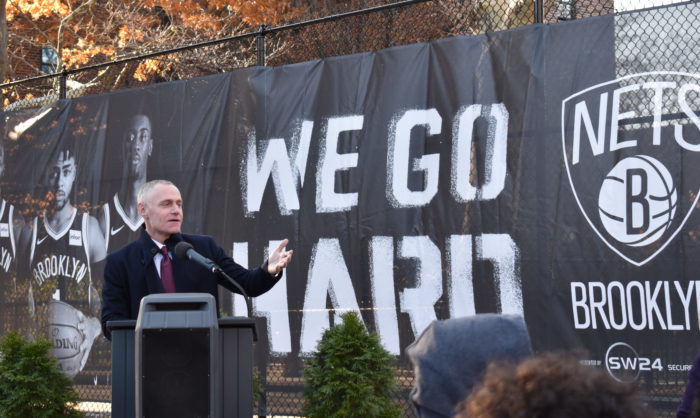
Brett Yormark, CEO of Brooklyn Sports & Entertainment, at a public-park dedication last week (Photo by Steve Koepp)
Yes, Barclays remains busy–it sold the seventh-most concert tickets of all the arenas in the world last year, second in the U.S. only to Madison Square Garden, according to Pollstar, a ranking it has maintained this year. Barclays recently welcomed its ten-millionth guest since its opening in 2012. But hosting the Islanders has proven financially treacherous.
The arena company’s recent fiscal-year 2017 financial results, not previously reported in the media, showed net revenues $18 million below estimates in a prospectus shown just last year to arena bond buyers. While the financial report didn’t name a particular cause, ratings agency Moody’s separately blamed lowered revenues and cash flow “caused by the attendance and related ticket sales decline” at Islanders games, plus the arena’s obligation to guarantee payments to the Islanders. The result: “a net loss from Islanders’ related business activities” in the last fiscal year, which Moody’s predicted would persist this season and next unless attendance picks up.
The Belmont Arena Gambit
The stage seems set for a game of arena chicken between Prokhorov’s camp and the Islanders owners, who have the financial backing of big-pocketed allies connected to Madison Square Garden and the Mets-owning Wilpon family. Their proposal for a hockey arena at Belmont is competing with just one other response to a request for proposals from Empire State Development, the state authority that controls the Belmont land: a bid for a soccer stadium from New York City FC. A third bidder just dropped out, likely strengthening the Islanders’ hand. Both bidders are expected to present renderings Sunday, Newsday reported.
Islanders co-owner Jon Ledecky recently hailed a revamped Islanders’ practice facility in East Meadow, Long Island, telling Newsday it was “the same kind of quality of excellence that we want to bring to the Belmont Park project.” But that cost just a few million dollars, not the hundreds of millions involved in building an arena. The Empire State Development is pondering the proposals with no announced decision timetable.
Even as BS&E’s Yormark opposes the Belmont plan, however, his company has shown its disappointment in the Islanders, at least under the current operating agreement. Yormark recently said of hockey in Brooklyn, “The economics just don’t work.” (Ledecky retorted: “I guess he’s saying the people on their side didn’t make a good deal.”) In January, Bloomberg reported that Barclays was “dumping” the Islanders, attributing that notion to “people familiar with the facility’s financials,” which may have been a tactical leak.
Not the Perfect Home for Hockey
The Barclays Center, downsized during the recession to focus on basketball (and save money) and with no parking lots for tailgating, is less than ideal as a hockey venue. The arena was already under construction when–after Nassau County voters in 2011 voted down a proposal to build a new arena–the Islanders started looking for a new home. The seating capacity at Barclays for hockey is 15,795, the second-smallest home venue in the National Hockey League. Four hundred of those seats have obstructed views of the rink, and far more have limited views, which have drawn scorn from fans. The awkward layout means the scoreboard is off-center and one end of the arena can look empty because fans shun the seats.
The Islanders’ first season, though bumpy, seemed promising. A 2016 consultant’s report aimed at arena-bond buyers said Barclays’ second anchor tenant added “incremental suite, sponsorship and concession income” and that the arrival of the Islanders “has been beneficial for the arena.”
Apparently, the boost lasted just one season, as the Islanders—with a proud history at Long Island’s Nassau Coliseum—haven’t established themselves the way the NBA’s Nets rebooted in Brooklyn after the move from New Jersey. Moody’s cited the “Islanders ownership’s inability to add to the existing fan base and build their brand in Brooklyn,” but that’s also the responsibility of BS&E, which has faced criticism from fans for failing to do just that. Though promising Brooklyn as “Tradition’s New Home,” arena managers proceeded awkwardly, for example, replacing the longstanding post-goal foghorn sound with a subway horn, then reversing course.
The Islanders’ average regular-season attendance dipped only slightly from 13,626 in their first year to 13,101 last year, but both were third-worst in the NHL. The Islanders missed the playoffs by a hair, after two previous post-season berths. Moody’s said the failure to build a brand in Brooklyn has hindered revenues from ticket sales, sponsorships, premium seating, and concessions.
This season, announced attendance over the first eleven home games averaged just 11,685, worst in the league. Though low early-season attendance is typical–last year, the Islanders averaged 12,379 after ten games—another downtick may be looming. When this reporter attended a game last Tuesday, the Islanders drew an enthusiastic but small announced crowd of 11,194. Hockey fans do apparently spend money inside: along with the regular concession stands and carts, individual vendors were stationed throughout the downstairs concourse to sell cans of beer from crates. (One vendor said hockey attendees drink “five times” more beer than basketball fans–not a scientific study, but you get the idea.)
But clearly there’s room for more fans. Six hours before puck drop Tuesday, ESPN’s schedule page indicated 3,361 tickets available, starting at $5, a lower price and larger ticket pool than in any other NHL game last week. This reporter paid a re-seller $15 for a ticket with a $35 face value.
Can This Partnership Be Saved?
In an unusual arrangement for a sports team and its landlord, Barclays runs the business side, including marketing, and keeps revenue from ticketing, sponsorships, and advertising, then pays the Islanders according to undisclosed guarantees. While reports suggested Barclays would pay $53.5 million annually, that left wiggle room regarding expenses. Barclays paid the Islanders $37.5 million in fiscal-year 2016 and $39.8 million in fiscal-year 2017, according to its financial reports.

At an Islanders game last Tuesday, fans were enthusiastic but thousands of seats were empty
The clock is ticking: the Islanders and the arena have until Jan. 1 to resolve “good faith discussions” to modify their 25-year deal, as Newsday noted. If they’re at an impasse, they can re-up the current terms—unlikely—or declare an opt-out by Jan. 30.
By the terms of the deal, the Islanders could jump before they’re pushed. The team could leave after this season or next, though Ledecky has said they’ll stay for a fourth year. Barclays, for its part, can eject the Islanders only after that fourth season. A resolution regarding the Islanders’ fifth season–a severed relationship? a short-term revision or extension?–may come before the fate of Belmont is known.
While neither Ledecky nor the NHL have expressed enthusiasm about the the Nassau Coliseum, Yormark has pushed it as the Islanders’ permanent home, while also saying he has given the Islanders owners “optionality” for playing at Barclays or some combination of the two. The Nassau facility has physical limitations, including tight concourses and no mass transit, and was downsized to 13,000 seats for hockey, but a sell-out exhibition game this year signaled abiding fan interest.
If the Islanders do win the Belmont bid, they’ll need a place to play during construction, so Barclays-plus-Nassau might surface as a possibility. If the Islanders don’t get Belmont, Ledecky has said he has no Plan B. If the team seeks to stay in the New York area, with their fan base and valuable local TV contract, Yormark likely has leverage to negotiate a better deal at Barclays and perhaps push the team to play some games at Nassau.
But if the Belmont proposal fails, Newsday‘s Islanders beat writer Arthur Staple thinks the team must consider leaving New York. Indeed, The Athletic website recently reported that NHL Commissioner Gary Bettman–who has three teams, including the Islanders, looking for venues–recently met with the owner of the Houston Rockets basketball team, who’d like to bring a team to its arena, which could seat 17,800 for hockey. (There are also arenas available in Seattle and Quebec City.) But Bettman’s first choice for the Islanders is Belmont, Newsday reported.
The Bid to Keep the Team
BS&E may be able to make Barclays a somewhat better home for hockey. A case in point: Barclays seems to be responding to complaints last year about inconsistent and choppy ice, attributed to the arena’s use of PVC piping for the chilling system rather than metal, which other arenas use. “If the relationship with the Islanders extends, we’re more than willing and able to accommodate them with copper piping,” Yormark said in June. In the meantime, players say the ice is better, apparently because the arena is being kept chillier, according to EliteSportsNY.
Barclays may not love the Islanders, but it likely fears a competing arena even more. A new Belmont facility, complete with a Long Island Rail Road stop and big parking lot for tailgating, could set up a battle royale in which the projected 150 new events at the arena would cut into the schedules at Barclays and Nassau. That hurts Prokhorov’s plan–he’s also renovating Webster Hall in Manhattan and the Paramount Theatre in Brooklyn–to be an entertainment colossus. (He’s divesting himself from basketball; Joseph Tsai, a tycoon in Chinese e-commerce, has agreed to buy 49% of the Nets, with an option to buy it all, in a deal that values the team at $2.3 billion.)
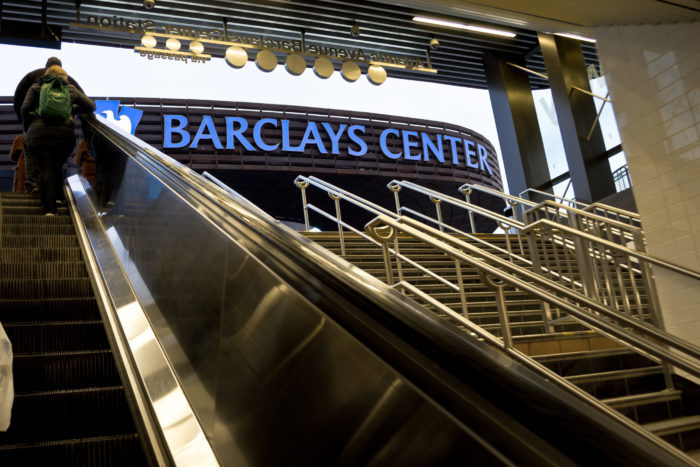
The view of Barclays Center as commuters emerge from the subway station on its front plaza (Photo by iStock/Getty Images)
As for the Islanders, though Ledecky calls Belmont the team’s “best home and the only home,” they should be careful what they wish for. Surely the new arena could draw more hockey fans. But the arena builders’ profits also must pay off construction.
One lesson from Barclays, which in its first year made what the Wall Street Journal called “generous deals to woo big names,” was that the buzz exceeded the profits. “The true test is years away,” concert promoter Jim Glancy told the New York Times in 2012, given that the arena honeymoon coincided with renovations at Madison Square Garden.
Another lesson: enthusiastic predictions and market studies commissioned by developers don’t necessarily hold up. As noted, Barclays’ fiscal 2017 net revenue (revenue minus expenses) fell to $28 million, barely half the $55 million that the arena’s developer, Forest City Ratner, predicted would be reached once the Islanders arrived and provided revenue stability. The latter estimate had been steadily downgraded from what now seems to have been a vastly over-optimistic $70 million.
The Debt Factor
What’s crucial to Barclays is keeping its financial results healthy enough to satisfy its bondholders. Prokhorov refinanced the arena’s bonds last year, securing a lower interest rate and smaller annual payments, but continued disappointing financial performance poses dangers for BS&E.
When the arena bonds were refinanced, Moody’s in August 2016 predicted that the debt service coverage ratio (DSCR)—a common metric used to describe the revenues available to pay off bonds—would reach 1.9x, or nearly twice the money needed. If it fell below 1.45x “on a sustained basis,” Moody’s said that could trigger a downgrade from Baa3—the lowest investment-grade rating—to “junk” status, which signals much higher risk. (BS&E declined to comment on the Moody’s analysis and other questions.)
Last year’s DSCR sunk to 1.31x and Moody’s predicts a further decline to 1.07x this fiscal year. For now, the arena does have cash reserves to survive lean years, Moody’s says. But if a downgrade comes, that could trigger sales of Barclays bonds by institutions that aren’t allowed to own junk bonds, and could raise the cost of potential future financing. Potential causes for a downgrade to “junk,” according to Moody’s, would include losing the Islanders without booking enough replacement events, or even keeping the Islanders and failing to lift revenues.
In other words, Yormark is not just fighting off a rival venue. He must also forge more certainty for an arena whose finances are more wobbly than its hulking steel edifice would suggest.

